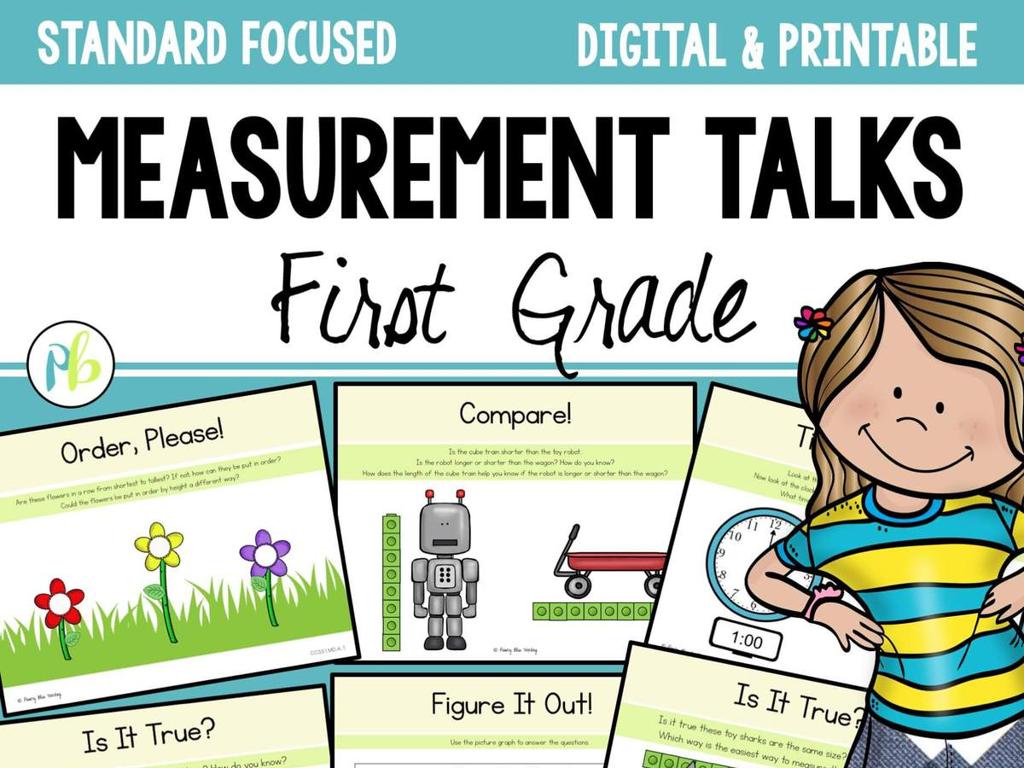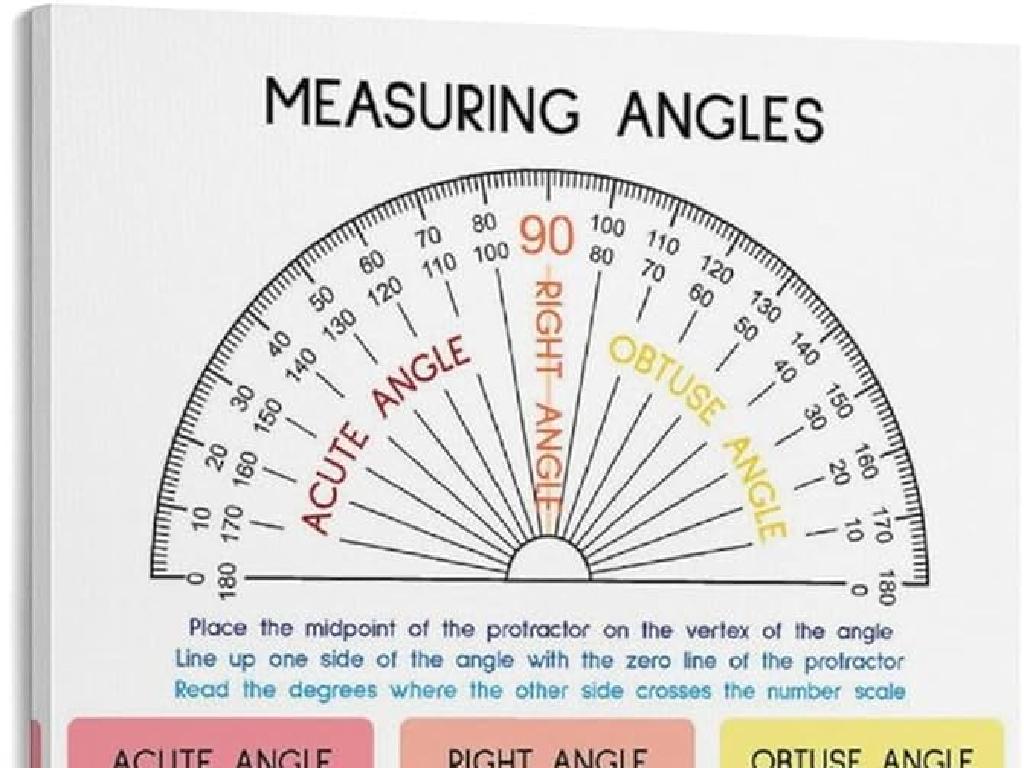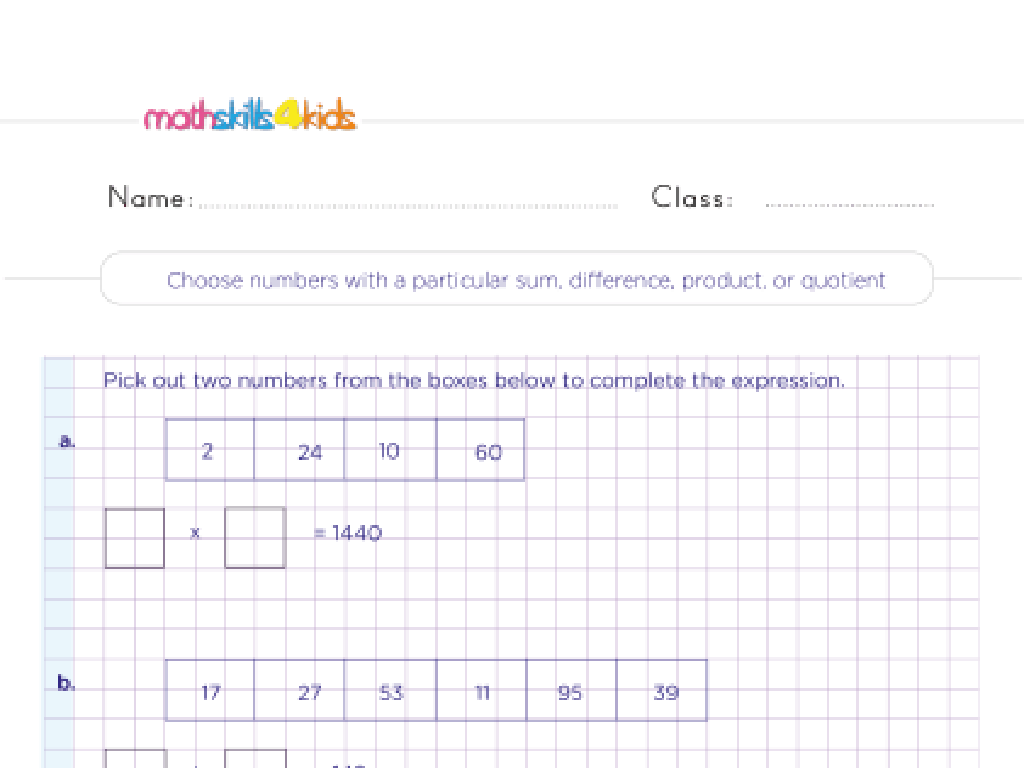Solve Equations With Variables On Both Sides: Word Problems
Subject: Math
Grade: Eighth grade
Topic: One-Variable Equations
Please LOG IN to download the presentation. Access is available to registered users only.
View More Content
Solving One-Variable Equations with Word Problems
– Understanding equations with variables
– Variables represent unknown numbers in equations
– Meaning of solving an equation
– Finding the value of the variable that makes the equation true
– Recap of one-variable equations
– Review past lessons on solving for x in equations like x + 5 = 12
– Transition to word problems
– Applying these concepts to solve real-life problems
|
This slide introduces the concept of solving one-variable equations within the context of word problems. Begin by explaining that variables are placeholders for unknown values in equations. Emphasize that solving an equation means finding the value of the variable that makes the equation true. Recap the methods learned in previous lessons for solving simple one-variable equations, such as isolating the variable on one side. This will serve as a foundation for applying these skills to more complex word problems. Encourage students to think about how these equations can represent real-life situations and prepare them for the upcoming examples and exercises that will solidify their understanding.
Solving Equations with Variables on Both Sides
– Identify equations with variables on both sides
– Understand the need for solving these equations
– Example: 3x + 5 = 2x – 7
– Find the value of x that makes the equation true
– Steps to solve the equation
– Combine like terms and isolate the variable on one side
|
This slide introduces students to equations that have variables on both sides, which is a common occurrence in algebra. Understanding how to solve these equations is crucial for students as it applies to real-world problems where relationships between variables need to be understood and quantified. Start with the example 3x + 5 = 2x – 7, and guide students through the steps to solve it: subtract 2x from both sides, then subtract 5 from both sides, resulting in x = -12. Emphasize the importance of maintaining balance by performing the same operation on both sides of the equation. Provide additional examples and practice problems to reinforce the concept.
Balancing Equations with Variables on Both Sides
– Isolate the variable: steps
– Use inverse operations to get the variable on one side
– Combine like terms
– Add or subtract similar terms to simplify
– Maintain equation balance
– Perform the same operation on both sides to keep it equal
– Practice with word problems
– Apply these steps to solve real-life problems
|
This slide introduces the process of solving equations with variables on both sides, which is a key skill in algebra. Start by explaining the importance of isolating the variable, which involves moving all variable terms to one side of the equation using inverse operations such as addition or subtraction. Emphasize the need to combine like terms to simplify the equation, making it easier to solve. Stress the importance of keeping the equation balanced by performing the same mathematical operations on both sides. Conclude by providing word problems for students to apply these steps, reinforcing their understanding through practical examples. Encourage students to work through the problems methodically and check their work by substituting the solution back into the original equation.
Solving Word Problems with Variables on Both Sides
– Comprehend the problem statement
– Formulate an equation from text
– Translate words into a mathematical model
– Example: Twice a number plus 15
– 2x + 15 = 3x – 9, where x is the number
– Solve for the unknown variable
– Rearrange to find x: x = 24
|
This slide aims to guide students through the process of solving word problems that result in equations with variables on both sides. Start by ensuring students understand the problem by reading it carefully and identifying what is being asked. Next, teach them to convert the word problem into an algebraic equation, representing unknown quantities with variables. Use the provided example to illustrate this process: ‘The sum of twice a number and 15 is the same as three times that number reduced by 9’ translates to the equation 2x + 15 = 3x – 9. Show step-by-step how to solve for x by isolating the variable on one side. Encourage students to check their solution by plugging it back into the original equation. This exercise will help students develop critical thinking and problem-solving skills.
Classwork: Solving Equations with Variables on Both Sides
– Solve for x: 4x + 8 = 6x – 4
– Subtract 4x from both sides and simplify
– Write an equation from a word problem
– Translate words into a mathematical equation
– Class activity: Practice problem-solving
– Apply learned methods to solve equations
|
This slide is focused on engaging students in solving equations with variables on both sides through practice problems. The first problem is a direct equation which students will solve by isolating the variable x. The second problem requires students to translate a word problem into an equation before solving. During classwork time, students will work individually or in groups to solve these problems, applying the steps they’ve learned. As a teacher, circulate the room to provide guidance and ensure understanding. Possible variations for the activity include peer teaching, timed challenges, or creating their own word problems. Emphasize the importance of checking their work by substituting the found value of x back into the original equation.
Group Activity: Equation Relay
– Form groups of four students
– Receive a set of word problems
– Collaboratively solve the equations
– Discuss strategies and work together to find solutions
– Present solutions to the class
– Each group explains their problem-solving process
|
This group activity is designed to foster collaboration and peer learning among students. Divide the class into groups of four and distribute a unique set of word problems to each group, ensuring that the problems require solving equations with variables on both sides. Encourage students to discuss the problems and work together to set up and solve the equations. After solving, each group will present their solutions and explain their thought process to the class. This activity not only reinforces their understanding of the topic but also enhances their communication and teamwork skills. Possible variations of the activity could include timed challenges, equation-solving races, or peer review sessions where groups evaluate each other’s solutions.
Review and Reflect: Equations with Variables on Both Sides
– Recap key concepts of solving equations
Balance equations by performing the same operation on both sides.
– Discuss common solving mistakes
Avoid errors like combining unlike terms or incorrect variable isolation.
– Reflect on effective strategies
Use strategies like simplifying terms and checking solutions.
– Encourage questions and clarifications
|
This slide aims to consolidate the day’s learning by reviewing the key concepts of solving equations with variables on both sides. Emphasize the importance of maintaining balance by performing identical operations on both sides of the equation. Highlight common mistakes such as combining unlike terms or incorrectly isolating the variable, and discuss how to avoid them. Encourage students to reflect on the strategies that they found most effective, such as simplifying terms before moving variables or double-checking their solutions by substituting them back into the original equation. Open the floor for students to ask questions or seek clarification on any points they are unsure about, fostering a collaborative and supportive learning environment.
Homework: Mastering Equations with Variables on Both Sides
– Complete the additional worksheet
– Practice setting up equations
– Translate word problems into algebraic equations
– Solve equations with variables on both sides
– Use inverse operations to isolate the variable
– Note down any questions for class
– Write any difficulties you encounter
|
This homework assignment is designed to reinforce students’ understanding of solving equations with variables on both sides. The worksheet provides additional practice to help students become more comfortable with translating word problems into algebraic equations. Encourage students to use inverse operations such as addition, subtraction, multiplication, and division to isolate the variable and solve for it. Remind them to check their solutions by substituting the value back into the original equation. It’s important for students to write down any questions or difficulties they encounter while completing the worksheet so these can be addressed in the next class. This will ensure that any misconceptions are cleared up and students can confidently solve these types of equations.
Wrapping Up: Equations with Variables on Both Sides
– Practice equations at home
– Utilize available help resources
– School website, math apps, or ask a teacher
– Next lesson: Systems of Equations
– Introduction to simultaneous equations
– Keep exploring word problems
|
As we conclude today’s lesson on solving equations with variables on both sides, it’s important to encourage students to continue practicing at home to solidify their understanding. Remind them of the resources they have at their disposal, such as the school’s math website, educational apps, and the opportunity to ask teachers for help. Give a brief preview of the next lesson on Systems of Equations, which will build on their knowledge of one-variable equations to solve problems involving two unknowns. Encourage curiosity and exploration of word problems to apply what they’ve learned in real-world contexts.





